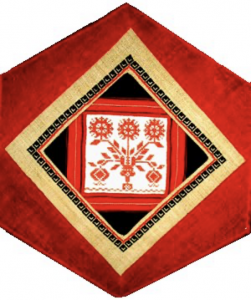Romania

The Block
The central image of this block was created on a piece of antique linen made from homespun flax, and is surrounded by hand-woven fabric taken from a Romanian skirt. The stylized representation of a plant is characteristic of Romanian folk art. It was cross-stitched by Doina Serban, using hand-dyed embroidery thread, and both it and the geometric design bordering the piece incorporate the traditional colour scheme favoured in certain regions of the country.
Cultural Profile
Romania, the largest Eastern European country after Russia and Ukraine, has been called ‘a miniature Canada’ because of its abundance of grain, timber and minerals. A quarter of the country’s territory is covered by pristine forests which harbour some of Europe’s last wolf and bear populations. The great Danube River ends in Romania, forming the Danube Delta. This area is one of the least inhabited regions of Europe and is home to the continent’s largest marshlands. The Carpathian Mountains form an arc across the country and curve around the region of Transylvania, known as the home to Prince Vlad III Dracula, also known as Vlad Tepes, who became one of the most famous characters in Western literature. Notable buildings in Romania include painted monasteries which display bright frescoes on their outside walls, fairy tale style castles clinging to the mountainsides, wooden churches and Baroque palaces in Bucarest, the nation’s capital, dubbed ‘Little Paris’.
The primary ethnic groups are Romanian, Hungarian, and Romany, the largest Gypsy community in the world. Romanian, a Romance language derived mainly from Latin, is the official language and minority languages include Hungarian, German and Turkish. English and French, taught in schools, are the most commonly spoken second languages. Romanians are extremely hospitable people, known to invite visitors into their homes, sharing what they have and expecting only friendship in return.
Romanian culture is derived mainly from the Roman, with Slavic, Hungarian, Greek and Turkish influences. Poems, folktales, literature and folk music such as the doina, traditional songs, are key cultural elements which have rich and varied histories. Romania’s New Year’s Day traditions are vibrant, especially in village centres: the ‘Little Plough’ songs are performed by children and for the mask dances, the dancers wear costumes to represent the characters known as the bear, the goat, the Gypsy, the bride or the elder. These dances are said to date back to pre-Christian times. Folk costumes, which are still part of special occasions, folk dancing and singing, feature colourful embroidery on both men and women’s attire.
Some of the national crafts for which the country is known include icon paintings, pottery, especially in the area of Horezu, embroidery, weaving of carpets featuring the ‘Tree of life’ pattern, textile decoration, and glass blowing. At the end of their shifts, glass-blowers will often make left-over glass into small ornaments, such as hearts or animals, and give them as tokens of friendship and good luck.
Romanians have been coming to Canada since the last half of the nineteenth century, although precisely why and when they first began to immigrate has not been definitively established. Those who came before the First World War were primarily farmers who hoped to acquire land. They settled in Western Canada and helped develop the country’s vast agricultural potential. Romanians who arrived after the war often had practical skills as tradesmen or technicians, or special professional qualifications and settled in major cities in Ontario and Québec. Romanian specialists have played key roles in many areas of Canadian society, including the manufacturing and service sectors, and Romanians in general have had important roles in the development of Canada as a trans-cultural society. Today, there are over 204,000 Canadians of Romania ancestry.
Sponsor: The Barker, J. Gazdik, P. Gazdik, Pyne and Walborn families
